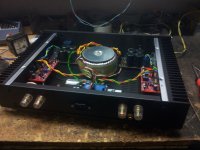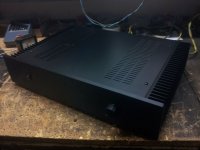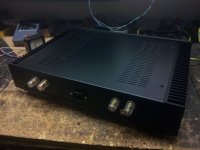Member
Joined 2009
Paid Member
Renesas and Alfet (from Semelab) if you prefer.
My point is that the 2SK1530/2Sj201 have different characteristics than IRFP9240/IRFP240 thus a different sound can be obtained for the same amp. Depending on other factors the difference could not be heard if you have limiting elements in your whole audio chain....
If someone believes that all power MOSFET and all power BJT sounds the same them it is pointless to persue this discussion for me....
Fab
I do believe such different FETs would sound different, but in an amp like this with very high feedback factors there will be a tendency for the loop feedback to crush any personality the devices might have. I would expect more audible differences in an amp with lower feedback factor.
I do believe such different FETs would sound different, but in an amp like this with very high feedback factors there will be a tendency for the loop feedback to crush any personality the devices might have. I would expect more audible differences in an amp with lower feedback factor.
You may be right for the effect of high feedback but it still may not prevent to hear a difference..... Unfortunately, for this amp, I can only rely on someone that have built the SKA before and sold it because not to his full liking. But when he listened to mine (with the other MOSFET) then he said to me that it sounded different and better from what he remembered. It may not be much evidence but still it gives the benefit of the doubt....
Fab
I have built over 50 different amps in the last 18 months. All have been tested on my A/B setup. I haven't tried all makes of output devices but quite a large variety including lateral and vertical MOSFETs and of course a variety of BJTs. When the output volume is equalized there is virtually no audible difference between 90% of the amps tested. The other day a fellow forum member posted this link to a Clark study. I must say I agree with it.
Richard Clark Amplifier Challenge FAQ
That said, the SKA boards I have built do display a more subdued sound in the mids and highs. I'm not opposed to trying different things to see if it can be improved.
Sir,
Which amp you found best in design and sound quality. Please share its details as well Thanks.
kamranyousaf
If you have read the past posts of still4given, you will note that many of his amps are equally good and fairly indistinguishable from each other. He frequents the slewmaster thread and I believe that is where his current interest is but he will correct me if I am wrong. He does like his honeybadger and that amp is fully supported with its own sticky thread. If you are interested in a good DIY amp you could start there. I would like to try a low bias (under 16mA) SKA built on Jim's boards and have gotten a very good head start from PauloPT but I still have some questions about it that I'm sure will get answered if I keep reading.
If you have read the past posts of still4given, you will note that many of his amps are equally good and fairly indistinguishable from each other. He frequents the slewmaster thread and I believe that is where his current interest is but he will correct me if I am wrong. He does like his honeybadger and that amp is fully supported with its own sticky thread. If you are interested in a good DIY amp you could start there. I would like to try a low bias (under 16mA) SKA built on Jim's boards and have gotten a very good head start from PauloPT but I still have some questions about it that I'm sure will get answered if I keep reading.
Sir,
Which amp you found best in design and sound quality. Please share its details as well Thanks.
Too many good choices to pick from. As said above I really like Ostripper's designs, i.e. Slewmaster series and Honey Badger. Others more equivalent in power to this are some of the Apex amps, and of course anything that vzaichenko designed.
Please don't let anything I have said put you off from building the SKA. It is a fine sounding amp with good power and a small footprint. No expensive parts and they are all easy to find. I have one of these in my amp stack for use in my A/B setup.
When using 4 ohm speakers, the recommendation is to lower the voltage rails of the amp but I had an idea for keeping the rails high and delivering more current. The IRFP240 part Greg uses has about 6A of transconductance but there are dual package parts like the 244 and the 150 that double this number, the first obstacle to using them is the lack of dual "P" compliments but suppose we piggyback two IRF9140s and mount them with a copper shim between them fastened directly to the heatsink as a heat spreader? Wouldn't this accomplish the goal with the higher rails? Even when operating just before clipping, these amps aren't known to run that hot, would there be enough temperature differential to be a problem?
Last edited:
Just an FYI,
I recently completed a set of Jim's Audio PCBs using matched pairs of Fairchild brand KSA992FBU/KSC1845FTA transistors as substitutes for the 2SC2240/2SA970 that I couldn't find.
These are nice because they are pin for pin compatible subs and very inexpensive from Mouser (<$10/100).
My PS is running at +/- 55V. The boards biased up exactly as expected and sound great.
These were suggested in an earlier post (I believe it may have been on this thread) that these should work and I would like to confirm that they do and thank the person who posted the suggestion.
I recently completed a set of Jim's Audio PCBs using matched pairs of Fairchild brand KSA992FBU/KSC1845FTA transistors as substitutes for the 2SC2240/2SA970 that I couldn't find.
These are nice because they are pin for pin compatible subs and very inexpensive from Mouser (<$10/100).
My PS is running at +/- 55V. The boards biased up exactly as expected and sound great.
These were suggested in an earlier post (I believe it may have been on this thread) that these should work and I would like to confirm that they do and thank the person who posted the suggestion.
Hi Terry ,can you post the pcb and shematic as built for this ska 150?Too many good choices to pick from. As said above I really like Ostripper's designs, i.e. Slewmaster series and Honey Badger. Others more equivalent in power to this are some of the Apex amps, and of course anything that vzaichenko designed.
Please don't let anything I have said put you off from building the SKA. It is a fine sounding amp with good power and a small footprint. No expensive parts and they are all easy to find. I have one of these in qpja my amp stack for use in my A/B setup.
Hi Terry ,can you post the pcb and shematic as built for this ska 150?
I used the Jim's Audio boards and built it per his schematic.
I used the Jim's Audio boards and built it per his schematic.
thanks,i want to try this if i can find a tested diy pcb posted in this thread
Who can help?
Last edited:
I might be able to help if it's only to build and test. I have two unpopulated boards that I can send you and maybe some parts. PM me and we'll hash out the details.thimios said:Who can help?
Thanks dellamaI might be able to help if it's only to build and test. I have two unpopulated boards that I can send you and maybe some parts. PM me and we'll hash out the details.
Regards.
In simulation this amp has much less distortion than the measurements in this thread. That's even using known accurate models.
The amp may be stable, but it may still have a ringing problem based on simulation and some scope shots in this thread. However there are many things that could be hiding this problem:
1: 750R/330pF low pass filter - only hides ringing, doesn't make the amplifier more stable.
2: The signal generator must have a fast risetime of 10nS or so, otherwise the test falls out of the scope of possible misbehavior of the amplifier.
3: Thick lines on oscilloscopes, especially pixelated digital ones hide the subtle ripple that shows the ringing.
The ringing looks like the image below in simulation, using 10nS risetime when the LP filter is removed.
Let me mention briefly that just because an amplifier rings does not mean it will ever oscillate. There is a high probability, yes, if it's the feedback loop that's ringing. However sometimes you will have film decoupling cause ringing which will show up on the output. Although it is still possible that an amplifier may have a ringing feedback loop without ever breaking into oscillation. It is of course considered undesirable and bad practice, one reason being that a resonator is like an antenna, and can cause RFI sensitivity.
If this amp is fully resonance-free without some sort of internal miller compensation, then the datasheets for the BC5xx must be wrong, or there must be some parasitic effect on the PCB.
The amp may be stable, but it may still have a ringing problem based on simulation and some scope shots in this thread. However there are many things that could be hiding this problem:
1: 750R/330pF low pass filter - only hides ringing, doesn't make the amplifier more stable.
2: The signal generator must have a fast risetime of 10nS or so, otherwise the test falls out of the scope of possible misbehavior of the amplifier.
3: Thick lines on oscilloscopes, especially pixelated digital ones hide the subtle ripple that shows the ringing.
The ringing looks like the image below in simulation, using 10nS risetime when the LP filter is removed.
Let me mention briefly that just because an amplifier rings does not mean it will ever oscillate. There is a high probability, yes, if it's the feedback loop that's ringing. However sometimes you will have film decoupling cause ringing which will show up on the output. Although it is still possible that an amplifier may have a ringing feedback loop without ever breaking into oscillation. It is of course considered undesirable and bad practice, one reason being that a resonator is like an antenna, and can cause RFI sensitivity.
If this amp is fully resonance-free without some sort of internal miller compensation, then the datasheets for the BC5xx must be wrong, or there must be some parasitic effect on the PCB.
Attachments
Last edited:
Bass and treble can seem soft on many Class A amps - I always just thought this was less distortion=less weight and smoother.. but someone else (who is probably more learned) might have another theory! 8)
It'm more than that. The amp loses bass slam and silvering highs.
And with 500mA bias the midrange is to die for! Beautiful female voices! The thing is that the highs are less present and the sound is less "exciting". It's more a "fat" sound. Also the amp sounds less loud, although the volume is kept unchanged. Is all this the result of less distortion?
- Home
- Amplifiers
- Solid State
- SKA GB150D now public domain...



